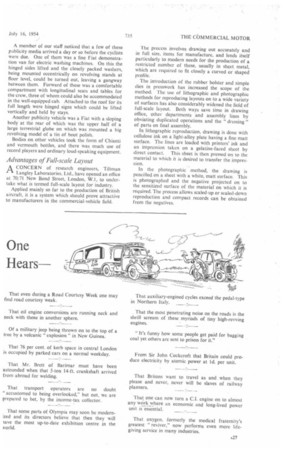Passing Comments
Page 28

Page 29

If you've noticed an error in this article please click here to report it so we can fix it.
Production Methods Exchanged
THE results of the Production Exhibition and Con ference held last week at Olympia seemed to assure success for this venture, which was sponsored by the Institution of Production Engineers and, organized by Andry Montgomery, Ltd., whose managing director is the efficient Mrs. M. A. Montgomery. The exhibition is to be held biennially and those responsible believe that its growth will be rapid.
The number and quality of the guests at the official opening augured well, and whilst it was regrettable that Mr. Peter Thorneycroft, the President of the Board of Trade, had to break his date because of his absence on duty in the U.S.A., his place was taken most adequately by the Minister of Labour, Sir Walter Monckton.
It was interesting to see at the exhibition the way A26 in which important exhibitors were willing to reveal their production methods, not only to the public but to their rivals. This is the kind of co-operation which will help Britain to maintain its trade both at home and abroad.
Publicity Vehicles in Italy
" NCILLARY operators in Italy have developed almost a craze for publicity vehicles, some of which are practicable as load carriers-whilst others may be described as being in the weird and wonderful category;
A good opportunity of seeing many of these was afforded by the recent circuit of Italy made by cyclists. They were tailed by dozens of these vehicles, which were also driven about in the cities and towns which formed the various nightly halting places. A member of our staff noticed that a few of these publicity media arrived a day or so before the cyclists were due. One of them was a fine Fiat demonstration van for electric washing machines. On this the hinged sides lifted and the closely packed washers, being mounted eccentrically on revolving stands at floor level, could be turned out, leaving a gangway between them. Forward of these was a comfortable compartment with longitudinal seats and tables for the crew, three of whom could also be accommodated in the well-equipped cab. Attached to the roof for its full length were hinged signs which could be lifted vertically and held by stays.
Another publicity vehicle was a Fiat with a sloping body at the rear of which was the upper half of a large terrestrial globe on which was mounted a big revolving model of a tin of boot polish.
Bodies on other vehicles took the form of Chianti and vermouth bottles, and there was much use of record players and ordinary loud-speaking equipment.
Advantages of Full-scale Layout
A CONCERN of research engineers, Tiltman 4-1 Langley Laboratories, Ltd., have opened an office at 70/71 New Bond Street, London, W.1, to undertake what is termed full-scale layout for industry.
Applied mainly so far to the production of British aircraft, it is a system which should prove attractive to manufacturers in the commercial-vehicle field. The process involves drawing out accurately and in full size, items for manufacture, and lends itself particularly to modern needs for the production of a restricted number of these, usually in sheet, metal, which are required to fit closely a curved or shaped profile.
The introduction of the rubber bolster and simple dies in presswork has increased the scope of the method. The use of lithographic and photographic methods for reproducing layouts on to a wide variety of surfaces has also considerably widened the field of full-scale layout. Both ways save time in drawing office, other departments and assembly lines by obviating duplicated operations and the " dressing " of parts on final assembly.
In lithographic reproduction, drawing is done with cellulose ink on a light-alloy plate having a fine matt surface. The lines are loaded with printers' ink and an impression taken on a gelatine-faced sheet by direct contact. This sheet is then pressed on to the material to which it is desired to transfer the impression.
In the photographic method, the drawing is pencilled on a sheet with a white, matt surface. This is photographed and the negative projected on to the sensitized surface of the material on which it is required. The process allows scaled-up or scaled-down reproduction and compact records can be obtained from the negatives.




























































































